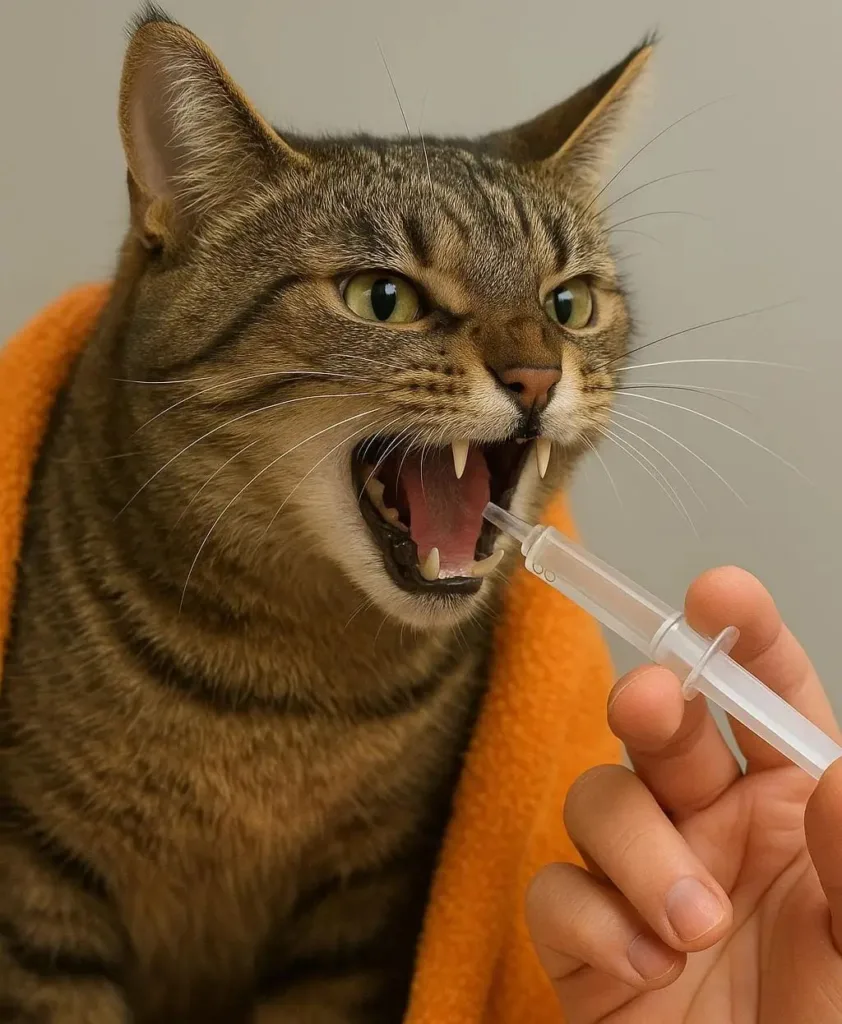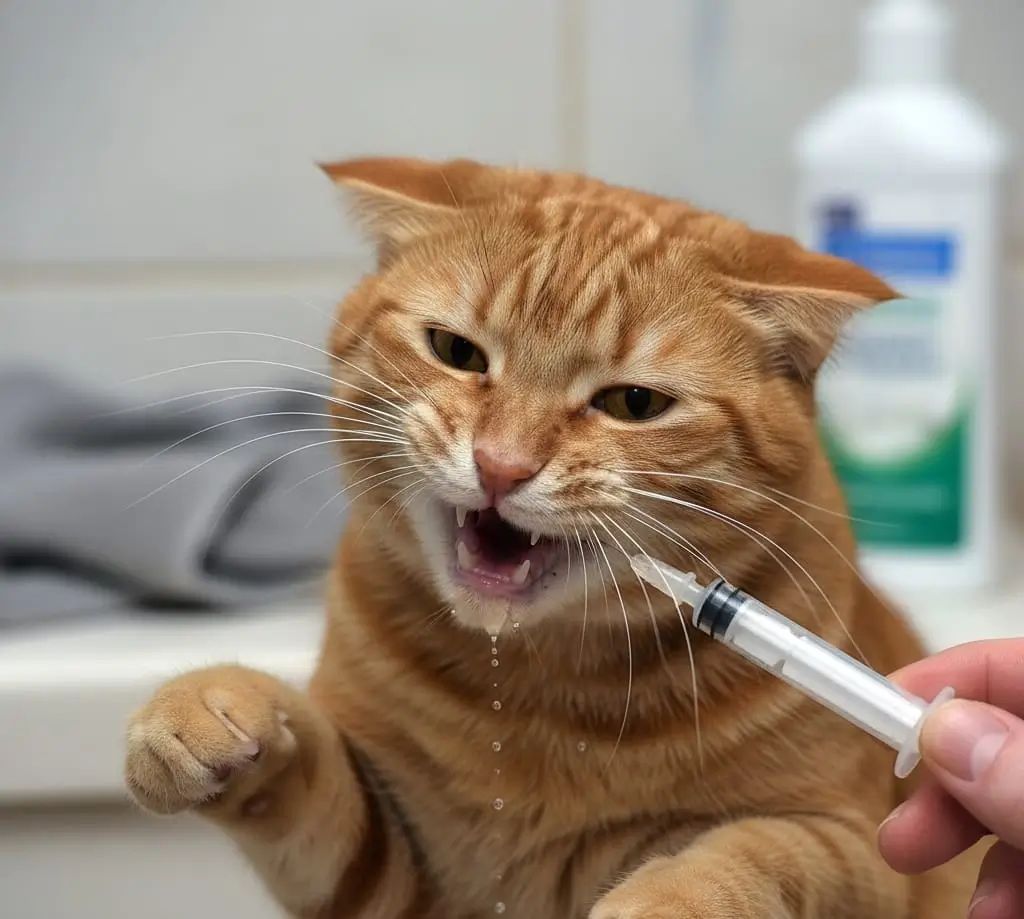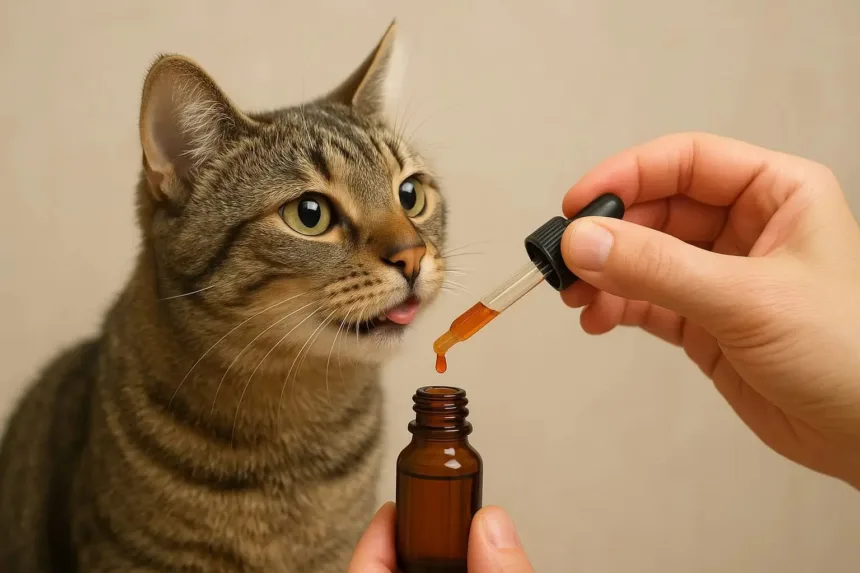Administering liquid medicine to an aggressive cat can feel like a daunting battle, but with the right techniques, patience, and preparation, you can make the process safer and less stressful for both you and your feline friend. Cats often resist medication due to its bitter taste, the unfamiliar sensation, or underlying discomfort from their illness, leading to scratching, biting, or fleeing. If you’re searching for “how to give liquid medicine to an aggressive cat,” you’re not alone—many pet owners face this challenge. This comprehensive guide draws from expert veterinary advice to provide in-depth strategies, covering everything from preparation to aftercare. By filling common content gaps like desensitization training and handling severe aggression, we’ll help you succeed while optimizing for cat health and your safety.
Whether your cat is feisty due to pain, fear, or just a strong personality, these tips ensure effective dosing without trauma. Always consult your veterinarian before starting, as they can recommend flavored formulations or alternatives like transdermal gels for chronic conditions.
Why Cats Resist Liquid Medicine and How Aggression Plays a Role

Aggressive behavior during medication isn’t personal—it’s a natural defense mechanism. Cats associate the syringe or dropper with discomfort, especially if the liquid tastes unpleasant. For aggressive cats, this can escalate to hissing, swatting, or full-on attacks, particularly in breeds like Bengals or Siamese known for high energy, or in seniors with arthritis making handling painful.
Key factors include:
- Taste and Texture: Most liquid medications are bitter, triggering foaming or spitting.
- Stress Response: Unfamiliar handling spikes cortisol levels, amplifying aggression.
- Health Issues: Underlying pain from conditions like urinary tract infections or hyperthyroidism can make cats extra defensive.
Understanding this helps you approach with empathy. Unlike basic guides that skip behavioral insights, recognizing triggers allows proactive calming, reducing the risk of injury to you (cat bites can lead to serious infections).
Essential Preparation: Setting the Stage for Success
Preparation is crucial for medicating a difficult cat, yet many articles overlook detailed setup. Start 30-60 minutes before dosing to minimize surprises.
1. Consult Your Vet Thoroughly
Discuss your cat’s aggression level. Ask about compounding pharmacies for flavored liquids (e.g., tuna or chicken) to mask bitterness—these can improve compliance by 50-70% in finicky cats. Confirm if mixing with food is safe, as some meds require an empty stomach.
2. Gather Supplies
- Oral syringe or dropper (1-3ml for cats; avoid needles to prevent injury).
- Towel or fleece blanket for wrapping.
- Treats (wet food, baby food without onions/garlic, or pureed tuna) for rewards.
- Pheromone spray or diffuser (like Feliway) to calm nerves.
- Gloves if your cat is prone to biting.
3. Choose the Right Environment
Pick a quiet, dimly lit room to reduce anxiety. Tire your cat out with play beforehand—laser pointers or feather toys can expend energy, making them less combative.
4. Prepare the Medication
Shake the bottle well, draw the exact dose into the syringe, and warm it to room temperature (hold in your hand for 1-2 minutes; never microwave). Test a drop on your skin—if it’s cold, your cat will resist more.
By prepping like this, you avoid mid-process fumbling, a common pitfall in rushed attempts.
Tools and Supplies: What You Need for Safe Liquid Medication Administration

Investing in the right tools makes “giving liquid medicine to a cat that fights back” far easier. Basic guides often gloss over options, but here’s a breakdown:
- Syringes vs. Droppers: Syringes offer better control for aggressive cats—opt for plastic, needle-free ones with a blunt tip to avoid gum injury. Size matters: 1ml for small doses, up to 5ml for larger.
- Restraint Aids: A “cat burrito” towel (large bath towel) immobilizes claws without full restraint. For severe cases, consider a cat muzzle or cone, but introduce gradually to avoid added stress.
- Flavor Enhancers: Pill pockets or liquid treat mix-ins (vet-approved) can disguise meds.
- Safety Gear: Thick gloves and long sleeves protect against scratches.
Pro tip: Practice with empty syringes filled with water or tasty broth to desensitize your cat over time—this long-term strategy is often missing from short-form advice.
Step-by-Step Guide: How to Administer Liquid Medicine to an Aggressive Cat
Now, the core: direct administration. These methods build on towel wraps and positioning, tailored for varying aggression levels. Always prioritize safety—stop if your cat shows extreme distress.
Method 1: The Towel Burrito Wrap for High-Aggression Cats
Ideal for scratchers or biters, this technique contains limbs while exposing only the head.
- Place a towel on a stable surface (table or floor). Gently place your cat in the center.
- Fold one end over the shoulders and back, tucking under the body.
- Bring the other end across in the opposite direction, securing under the chest like a swaddle. Hold the ends or tuck under your arm—your cat’s front paws should be contained, but allow breathing room.
- Sit with the wrapped cat in your lap, facing away. Use your non-dominant hand to gently hold the head (thumb and forefinger on cheeks).
- With your dominant hand, insert the syringe into the side of the mouth (between cheek and molars, behind canine teeth).
- Tilt the head slightly upward (not backward to avoid aspiration). Squirt slowly—1/4 dose at a time—aiming for the back of the tongue.
- Stroke the throat or blow gently on the nose to encourage swallowing. Hold for 10-15 seconds.
- Unwrap immediately and offer a treat.
For extra aggression, enlist a helper to hold the wrap while you dose.
Method 2: Arm Cradle Hold for Mildly Resistant Cats
Less invasive, great for cats who squirm but don’t attack.
- Sit comfortably and cradle your cat like a football in the crook of your arm, facing away, with legs tucked.
- Secure the body with your forearm; use your hand to stabilize the head under the chin.
- Insert the syringe at a 45-degree angle into the cheek pouch.
- Dispense gradually, pausing if the cat resists. Follow with chin scratches.
Method 3: Table-Top Positioning for Control
For larger cats or if you’re solo:
- Place your cat on a non-slip surface. Kneel and form a “V” with your legs to trap the body gently.
- Hold the head from behind, tilting slightly.
- Administer as above, using gravity to aid swallowing.
In all methods, go slow—rushing leads to spitting or incomplete doses. If your cat foams, it’s often just taste reaction; wipe gently but don’t redose.
Alternative Methods: When Direct Dosing Isn’t Feasible
If your aggressive cat won’t tolerate syringes, explore these vet-backed options, often underexplored in standard guides.
1. Mixing with Food
Only if vet-approved. Hide in 1-2 teaspoons of wet food, baby food, or yogurt. Use a “parfait” layer: food, med, food in a syringe for controlled delivery. Ensure full consumption to avoid underdosing, which can breed resistance.
2. Flavored Compounding
Pharmacies can create tuna-flavored liquids, extending shelf life tips to 30-45 days.
3. Transdermal or Injection Alternatives
For ongoing meds, ask about ear gels or vet-administered shots to skip orals altogether.
These reduce aggression by making the process voluntary.
Handling Common Challenges: Foaming, Biting, and Spitting
Aggressive cats often react dramatically—here’s how to manage:
- Foaming or Drooling: Common with bitter meds; it’s saliva, not poison. Offer water afterward to rinse.
- Biting or Scratching: Wear protection; if bitten, clean immediately and seek medical care—cat mouths harbor bacteria.
- Spitting Out Dose: Estimate swallowed amount; if unsure, skip and consult vet to avoid overdose.
- Gagging: Caused by forceful squirting—always aim sideways and slow.
For severe cases, sedatives like gabapentin (vet-prescribed) can mellow your cat pre-dose.
Aftercare: Ensuring Your Cat’s Recovery and Comfort
Post-dosing care is a frequent gap in medication guides—neglect it, and future sessions worsen.
- Monitor Closely: Watch for vomiting, lethargy, or refusal to eat/drink for 1-2 hours. Note any allergic reactions like swelling.
- Soothe Stress: Provide a quiet space, extra pets, or interactive toys. Use pheromone products to reset mood.
- Hydration Boost: Encourage water intake with fountains or flavored additives to flush the med.
- Track Progress: Log doses, reactions, and successes to share with your vet.
If a dose is missed, don’t double up—follow label instructions.
When to Seek Professional Help: Knowing Your Limits
You shouldn’t battle alone if aggression endangers you or your cat. Red flags include:
- Repeated failure to dose (risking treatment failure).
- Severe injuries from scratches/bites.
- Extreme distress signs like dilated pupils or hiding for days.
- Medication-specific issues, like esophageal irritation from pills (though less common with liquids).
Take your cat to the vet for clinic administration, or explore hospitalization for short-term dosing. For chronic needs, discuss implants or automated feeders.
Long-Term Strategies: Desensitization and Prevention
To make “how to give medicine to a difficult cat” easier over time:
Daily Practice
Use empty syringes with treats weekly to build positive associations.
Routine Building
Dose at mealtimes, pairing with favorites.
Behavioral Training
Clicker training rewards calm behavior; consult a feline behaviorist for aggressive patterns.
Health Management
Address root causes like pain with joint supplements, reducing baseline aggression.
These proactive steps, often absent in quick-tip articles, can transform medication time from ordeal to routine.
Conclusion: Empowering You to Medicating Your Aggressive Cat Successfully
Giving liquid medicine to an aggressive cat requires technique, tools, and tenderness, but it’s achievable with these expert strategies. By covering gaps like aftercare and desensitization, this guide equips you for long-term success while incorporating SEO keywords like “aggressive cat medication tips” for easy reference. Remember, your vet is your best partner—reach out for personalized advice. With patience, your cat’s health will improve, and those battles will become a thing of the past.
FAQ:
Can I mix my cat’s liquid medicine with wet food or treats?
Only if your veterinarian confirms it’s safe. Some medications need an empty stomach or can lose effectiveness when mixed with food.
What is the easiest way to medicate a highly aggressive cat alone?
Use a towel “burrito” wrap on a non-slip surface, keep the cat facing away, and work calmly. Practice with water beforehand to desensitize your cat.
How can I calm my cat before giving medicine?
Play with your cat to burn energy, use pheromone sprays like Feliway, or ask your vet about mild sedatives (e.g., gabapentin) for extreme cases.
What should I do if my cat spits out or foams after taking medicine?
Foaming is usually a reaction to the bitter taste. Don’t re-dose unless advised by your vet—call for guidance if you’re unsure how much was swallowed.
Are there alternatives to oral liquid medication for aggressive cats?
Yes. Ask your vet about transdermal gels (absorbed through the ear) or long-acting injections for certain medications.

